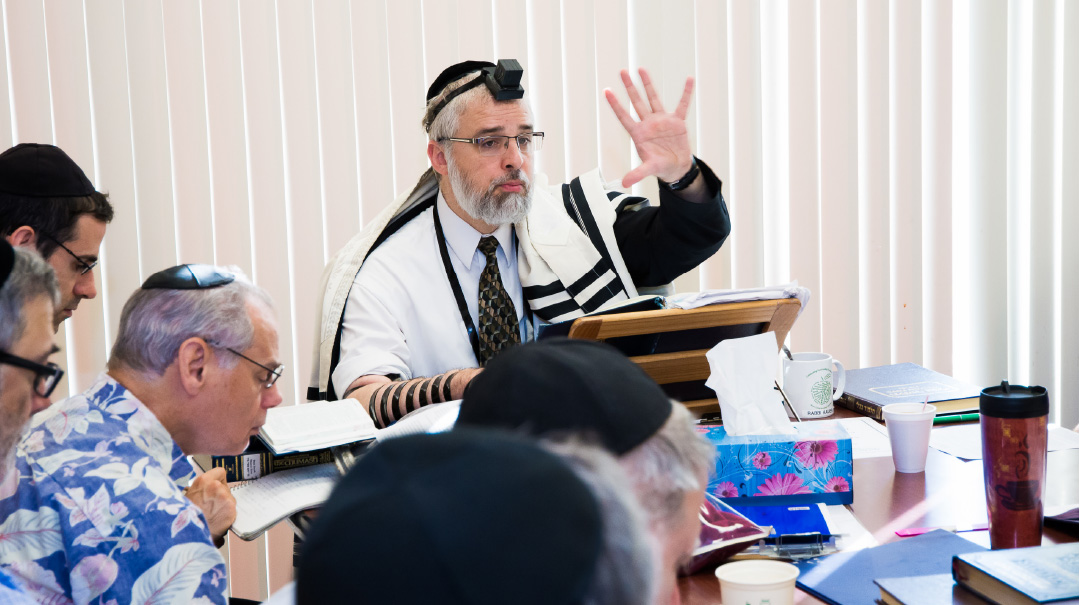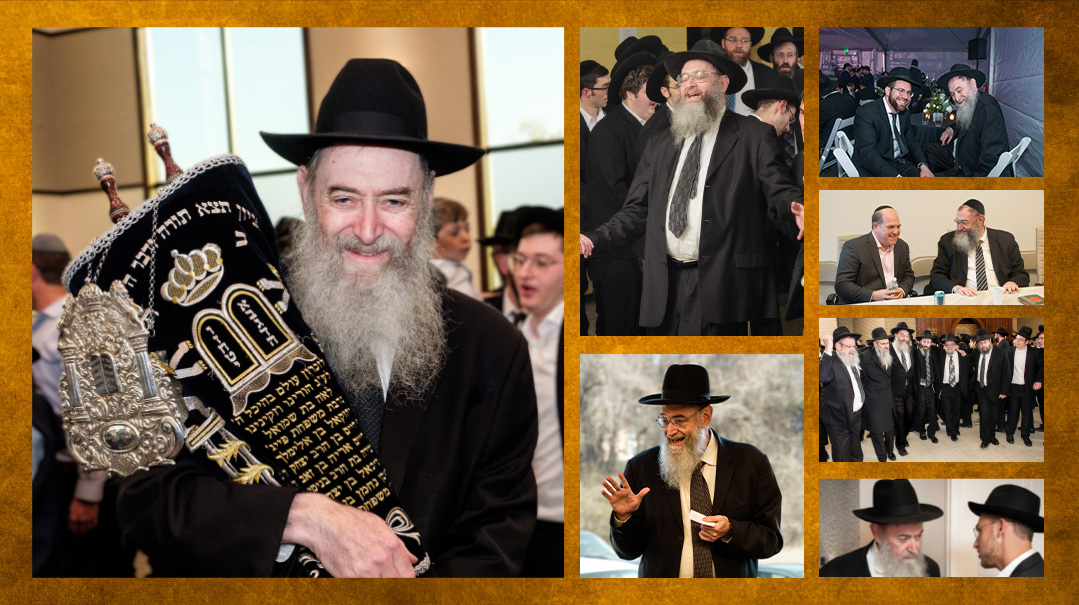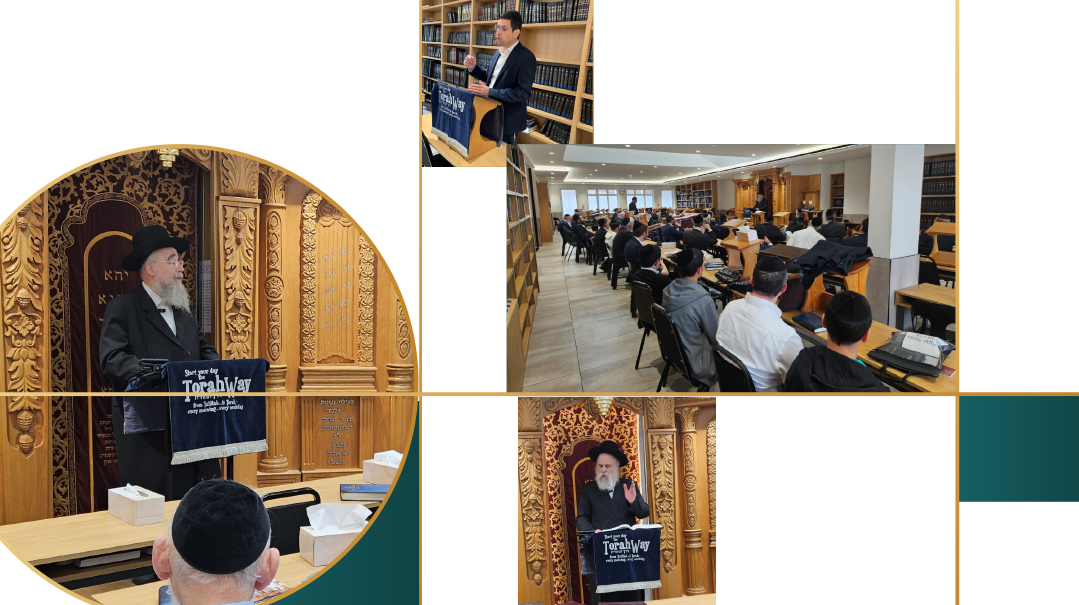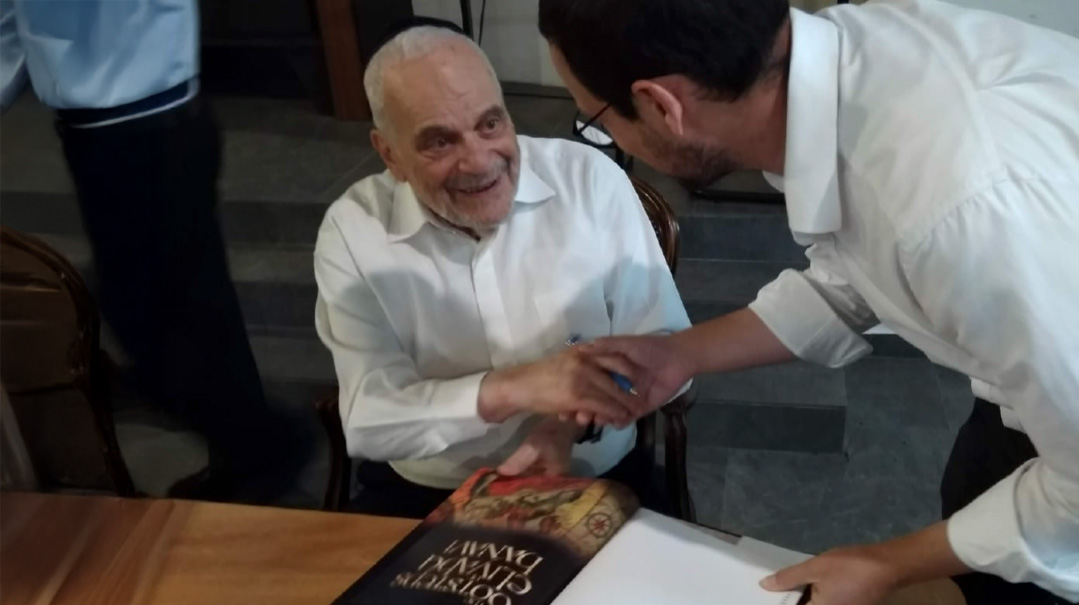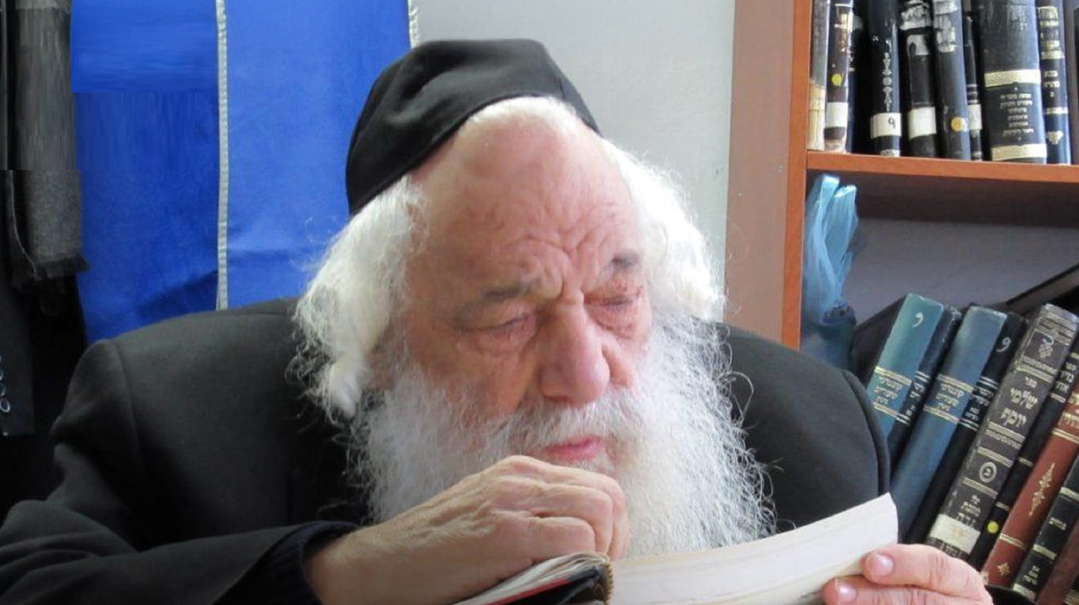Song of the Spirit

Mourning Rav Avraham Yisrael Portugal of Skulen
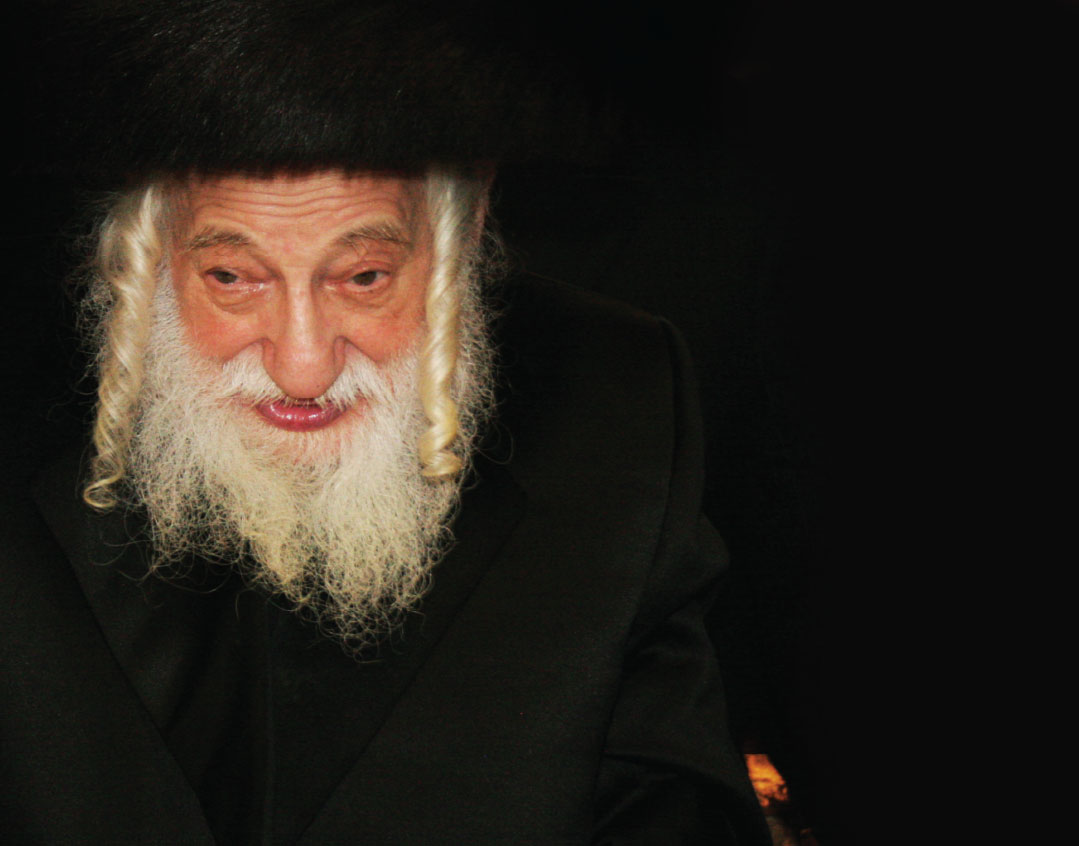
H
e was a small, frail man who had seen some of the worst destruction and oppression of the twentieth century – the physical destruction of the Nazi regime and the ideological oppression of the Communist regime. He survived beatings, prison, and privation – and throughout it all, he maintained his singular focus on the world of the spirit.
Rav Avraham Yisrael Portugal of Skulen glowed with purity and with a gentle love and concern for his fellow Jew. For decades, he led as a chassidic Rebbe, but he never made any concerted effort to expand his court and his community. Instead he invested all his energies – and beyond – in Yidden all over the world, young and old, close and far. Even very far.
Instead of building up his chassidus, he distributed huge sums of money to people in need. His life’s work was the Chesed L’Avraham organization in Eretz Yisrael, which provided physical and spiritual support to children from compromised homes.
In his simple, nearly Spartan home in Boro Park, one could find Yidden of all stripes, waiting expectantly to give him their kvittel and pour out their hearts. They were able to sense the tremendous heart that pulsed with care for an entire nation.
The Rebbe did not build an elegant chatzer. “The Rebbe built souls,” those who were very close to him relate. “He built worlds for Hashem.”
For himself, he needed nothing. He hardly ate or slept; he allotted his body just what it needed to survive. Yet he’d turn over the world to help a single needy Jew.
A Strength Beyond Nature
The Skulener court is unique among chassidic courts today. It’s located in a three-story house on Thirteenth Avenue, the plainest house on the avenue. The floorboards squeak, the furniture is minimal. But the people who came here were seeking a different kind of wealth.
Entire families climbed the stairs of the house to submit a kvittel with their troubles to the tzaddik of the generation. They waited outside the famous white door with a gold handle, on the second floor of the simple house. This door leads to the Skulener Rebbe’s room, which was active from night to night. Everyone has visited this room, from philanthropists, to Rebbes, Roshei Yeshivah, community leaders and simple people.
On a typical morning, as schoolbuses would rumble by and men would hurry to Shacharis, time stood still inside the Skulener court, as the Rebbe would receive petitioners, a process that started in the middle of the night, but regularly overflowed into the morning hours.
The Rebbe received everyone with a kind smile. When he rose to accompany a prominent person to the door, it was evident that his gait was weak and his body was afflicted by his age, his afflictions and his abstention from all physical comforts. When his eyes were open, he appeared like an angel. His body was here, but his thoughts, so it seemed, were far away, in much more sublime realms.
The Skulener Rebbe’s schedule astonished all those who knew him. Back as a young man, his tefillos took a very long time and great effort. But even as he advanced in years, his avodas hatefillah did not wane. This was a Yid who endured countless tribulations and once nearly lost his life when the Communists in Romania attempted to hang him.
His smile never left his face, and his eyes radiated joy like two powerful torches.
The Rebbe could finish Seudah Shlishis deep in the night on Motzaei Shabbos. Then he would daven Maariv, make havdalah and wash for a lofty Melaveh Malka that would last until the morning, and would include stories of tzaddikim and sichos kodesh, distribution of garlic as a segulah and special songs. Then, as the sun slowly began to rise, the Rebbe would burst into song of “Hame’ir la’aretz veladarim aleha berachmamim...”
Another area in which the Rebbe invested tireless efforts throughout his years was in guiding chassanim in building a pure Yiddishe home. The holiness of Am Yisrael was something that burned in his bones from a very early age.
Visit his bais medrash for davening and tischen, and you wouldn’t find large crowds. But when the Rebbe traveled out of Boro Park for Shabbos, to Williamsburg or London, masses thronged to the tefillos and tischen. His pure avodah was the same whether he was surrounded by a minyan or a multitude. It was all for Hashem.
Interestingly, many Chassidim in America are sure that the Skulener Rebbe was an admirer and chassid of their own rebbes. Although he received kvittlach throughout the week from countless people seeking brachos, the Rebbe was known to write and submit a kvittel of his own to any rebbe in the generation.
The Early Years
The Rebbe was born in 1923 in the city of Skulen in the Moldova region on the Romanian border. Skulen was a vibrant Jewish town that was home several hundred Jewish families. His father, Rav Eliezer Zusia Portugal, ztz”l, served as the rav of the city. (It is thought that the Portugal family was thus named because of its roots in that country. The family seems to have been descended from expulses from Portugal and over the years, traveled to Russia and settled there.)
Rav Eliezer Zusia traveled often to Stefanesht, to bask in the presence of the Rebbe, Rav Avraham Mattisyahu Friedman, ztz”l. His young son, Yisrael Avraham, would join him, in order to imbibe from the Rebbe’s holiness and purity. The memories of those holy visits remained deeply etched on the Rebbe’s soul for the rest of his life.
When the Rebbe shared memories of the past, he would describe, among other things, the remarkable avodas hakodesh he witnessed in Stefanesht when the Rebbe recited Kiddush on Friday night.
The Rebbe was just nine when his father sent him to Vizhnitz to learn in the yeshivah of Rav Eliezer Hager, the Damesek Eliezer, zy”a, the son of the Ahavas Yisrael, Harav Yisrael Hager of Vizhnitz, zy”a. He sang his father’s songs there, and the Damesek Eliezer enjoyed them so much that he was encouraged to start composing his own song.
At the age of ten, he composed his first song to the words Yiru Eininu, a niggun sung with great emotion by Chassidim to this day. It was just the first of an impressive repertoire of hundreds of compositions that the Rebbe created over his 96 years on this earth.
He utilized his time in yeshivah to make great strides in ruchniyus and Torah knowledge. One of the students in the yeshivah at the time was Rabbi Moshe Yosef Lass, z”l, later a resident of Jerusalem, known for his tradition distributing steaming coffee to people at the Kosel for many years. He recalled seeing young Yisrael Avraham walking around the yeshivah between sedarim with a Sefer Tehillim in his hand. He never stopped murmuring the psukim, with a special tune. “Even back then we realized that he there was something special about him,” he said. “He was unusually serious about his learning, and he had spiritual ambitions suited to someone far older.”
After his bar mitzvah, the Rebbe switched to the yeshivah of Rav Yehudah Leib Tzirelson, ztz”l, the Rav of Kishinev, where he learned for five years, becoming proficient in Shas and poskim. From there, he returned to his father’s court, which had moved to Chernowitz, and from that point on, he was his father’s right hand in the many tzedakah and chesed endeavors, a path in life he maintained until his final day.
A Day in Skulen
Reams have been written about the Rebbe’s outstanding avodas Hashem. His lengthy Krias Shema during a regular weekday Maariv was an unforgettable sight.
A tzaddik’s eating is likewise a holy avodah, and as such, the Shabbos seudos at the Skulener tischen were lengthy, exalted affairs. The Rebbe wasn’t accustomed to eating much, but on Shabbos, when every bite is a mitzvah, he exerted himself to the utmost.
In fact, from a very young age, the Rebbe would fast every Monday and Thursday, the Rebbetzin once related. But the day he was saved from prison in Romania, where he was held after the Holocaust due to his activities to save Jews, was a Wednesday. He was extremely weak and couldn’t even stand on his feet. On Thursday morning, the Rebbetzin prepared especially nourishing dishes for the Rebbe’s midday meal. To her surprise, the Rebbe informed her that he was fasting as usual.
“In your current condition, you’re fasting?!” she asked.
“Yes, particularly now,” came the Rebbe’s reply. “I didn’t sit in prison for nothing. It was due to my sins, and I must repent with fasting.”
That was just a small example of the extreme rigor that characterized the Rebbe’s life. Before accepting the mantle of leadership, he would sit awake learning all night for nine hours straight until daybreak. Then he’d prepare himself for davening, after which he’d rest for two hours. However, after he accepted the leadership of the court of Skulen, he undertook a very sublime, exalted path.
No longer was he seen in public learning Torah. After several hours of receiving petitioners, about half an hour before alos hashachar, the Rebbe would receive a meal -- the only food he’d eat for 24 hours. At daybreak, he’d lock himself in his room until 9:30 a.m. – apparently that was when he learned – and afterward, he’d rest for two and a half hours.
At 11 a.m., preparations would begin for Shacharis, about an hour and a half until he immersed in the mikveh, which also took about an hour and a half. In the mikveh, the Rebbe would recite all the names that appeared on the kvittlech given to him by his gabbaim. People from all around the world would call at all hours of the day and night, and the gabbaim would write down those names. By the time the Rebbe emerged from the mikveh, a new list of names would be accumulated, and the gabbai would hand him those names. Since some necessitated an immediate response, the Rebbe would read the notes and give his reply and brachah, according to the matter at hand.
At around 3 p.m., the Rebbe begin Shacharis, but there were times when people had to speak to him about urgent matters of pikuach nefesh.
In the past, bochurim on the day of their bar mitzvah would wait silently for the Rebbe until he was ready for Shacharis, so that the Rebbe would place their tefillin on them; however due to the Rebbe’s complex schedule and the large numbers of bachurim crowding the beis medrash, the gabbaim decided to limit the tefillin-laying ceremony to Sundays. That didn’t prevent dozens of bochurim from gather and wait excitedly for the Rebbe to place their tefillin on them.
The Rebbe had a custom to serve as sandak at brissim held in his beis medrash. The brissim were held immediately after Shacharis, which meant just before shekiya.
After Shacharis, the Rebbe would hurry to daven Minchah and then Maariv, after which the line of petitioners would begin to snake outside his door.
On days when the Rebbe’s one daily meal included a fleishig dish, he’d forgo his coffee with milk, waiting a full 24 hours between the meat and milk. Thus the Rebbe didn’t just fast every Monday and Thursday, but daily.
Fierce Warrior
The same Rebbe who had a gentle love for each Jew became an uncompromising warrior when it came to matters of kedushah. American Jewry saw him as a spiritual bulwark, relentlessly protecting them from the intrusion of foreign values.
Someone unfamiliar with Skulen would be hard put to comprehend how this frail, elderly Rebbe with the face of an angel – someone who’d never partaken of the pleasures of this world -- had such a deep understanding of modern-day temptations.
Yet at the age of more than ninety, he undertook one of the most unlikely battles of his life. Along with ybl”c Rav Mattisyahu Salomon, the mashgiach of Beis Medrash Govoha of Lakewood, he launched a battle to heighten awareness of the dangers of the internet culture.
The Rebbe saw internet and its accompanying culture as a destructive force. “When a fire breaks out,” he explained, “we do everything to extinguish it: we call the firefighters and people run to help. This is a fire that’s consuming entire homes. People are being uprooted from all that’s holy – from their parents, grandfathers, grandmothers; they’re becoming strangers to all who love them.”
Just as he mourned the casualties of this destructive force, he celebrated the triumphs of those who overcame the small, daily battles that it presented. “The strength of Am Yisrael is different from the strength of the nations of the world,” he explained. “Among the other nations, whoever possesses more planes or the weapons holds more power. With Am Yisrael, he who conquers his yetzer holds the power. And those who capture their yetzer help win our physical wars as well. Every Jew who triumphs in his own personal battleground brings victory to all Jews.”
Thousands of Children
The Rebbe harbored a deep love for every member of Klal Yisrael, especially the children. This love was the cornerstone of his organization Mosdos Chessed L’Avraham, a unique organization in Eretz Yisrael that offered educational institutions and support to children from unstable homes or children of immigrants.
For the Rebbe, these were his children, and he felt a personal impetus to care for their physical and spiritual needs. Whenever he met them, especially when visiting Eretz Yisrael, everyone could see the light on his face.
A wealthy man once came to the Rebbe and announced that he had decided to purchase the building next door to Skulen for the mosdos. It was six stories high and each floor spanned a thousand square meters. It would be for the personal use of the Rebbe and his many followers. When the gabbaim happily came to tell the Rebbe the news, his response stunned them: “We don’t need it. We have enough space in this house. Tell the gvir he should give the building to families who need a place to live.”
The educational institutions of the Skulener Rebbe were always run according to the motto that every Jew who stood at Sinai has the potential to be as great as Moshe Rabeinu. “Don’t look at the cost; don’t take personnel into consideration. Nothing should stand in the way of the need to bring another Jew under the wings of the Shechina, so that he will develop into a shomer Torah umitzvos. You must think of each child who learns in the institution as if he were your biological child,” was the Rebbe’s education policy.
The Rebbe had a strong affection for children from the Sephardic community, who formed the majority of the student body at the Chesed L’Avraham institutions. When he visited Eretz Yisroel, he’d visit one school after another, in order to see firsthand the tremendous activities accomplished by the devoted staff, and get a sense of the individual flavor and needs of each school.
Before undergoing an extremely complicated, high-risk operation, the Rebbe asked his children, the students of Chesed L’Avraham, who are closer to Hashem than anyone else, to daven for him. They were convened for tefillah rallies and inspirational singing, and were encouraged to take upon themselves kabbalos for the merit of the Rebbe. After his recovery, the Rebbe returned full force to his avodas Hashem and devoted work on behalf of Klal Yisroel.
Final Days
During the last period, the Rebbe grew increasingly weak and was transported to John Hopkins Medical Center in Maryland for medical treatment. His chassidim entreated their fellow Jews to daven for his recovery – and all across the globe, in small shteiblach and large batei medrash, Jews fervently prayed for the small giant with the glowing eyes who brought song, succor, and spiritual salvation to so many.
On Tuesday evening this week, his pure soul finally broke free of the afflicted body that had endured so much and seen so much history. Grief and mourning spread across the world. After so many decades in the shadow of his pure spirit, our generation has lost a champion of purity, of kindness, and of uncompromising values.
True, he didn’t invest much effort building a court, but the Skulener Rebbe built so many souls.
Yehi zichro baruch.
(Originally featured in Mishpacha Issue 755, Special Supplement)
Oops! We could not locate your form.







